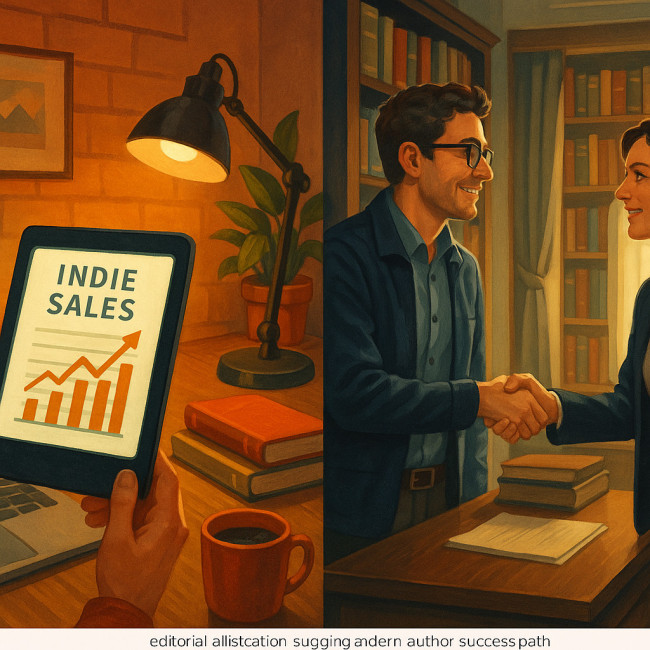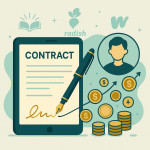Find an agent or stay indie? Pros, cons, and decision framework for authors
You have a finished manuscript and a folder full of dreams. Now comes a pivotal crossroads: sign with a literary agent and pursue traditional publishing, or release your book independently. This guide weighs each path's advantages, warns of hidden pitfalls, and offers a step-by-step decision framework so you can move forward with clarity and confidence.
Traditional agent vs. indie publishing: the quick snapshot
| Factor | With an agent (traditional) | Indie publishing |
|---|---|---|
| Up-front cost | Minimal (agent works on commission; publisher funds production) | You fund editing, design, marketing |
| Royalty rate* | Print ≈ 10% of list, e-book ≈ 25% of net, minus 15% agent fee | Up to 70% of list (e-book), 40–60% of list (print-on-demand) |
| Advance potential | Yes, but recoupable | No advance (except crowdfunding) |
| Speed to market | 18–30 months after deal | 4–12 weeks after final edits |
| Distribution reach | Bookstores, libraries, foreign rights | Online retailers; extended distro costs extra |
| Creative control | Publisher final say on cover, edits, pricing | You decide everything |
| Marketing support | Publicity team, but heavily list-driven | DIY or hired specialists |
*Industry averages compiled from 2023 publisher catalogues and online retailer payout tables.
Pros and cons unpacked
What a literary agent brings to the table
- Market leverage. Agents know which editors crave your genre and how to spark an auction.
- Contract protection. They negotiate option clauses, royalty escalators and reversion timelines—saving you from long-term IP headaches.
- Foreign & subsidiary rights. Film, audio and translation deals often come faster through an agent's network.
- Editorial development. Many agents offer structural feedback that can elevate a good manuscript to sellable.
Hidden downsides of the agent route
- Time sink. Querying can take 3–12 months; submission rounds add more waiting.
- Loss of control. Pricing, cover design and even title may change without your final approval.
- Lower lifetime earnings for niche titles. If you write in a micro-market, a 10% print royalty may never outrun indie revenue.
Why authors choose the indie path
- Speed. From “final draft” to global storefronts in under two months.
- Creative freedom. Own your cover, set your price, update editions whenever you wish.
- Higher per-unit margin. Retailer portals such as KDP pay up to 70% on e-book sales.
- Agile marketing. You can pivot ads, bundles and newsletter swaps overnight.
The indie challenges you can't ignore
- Upfront investment. Professional editing, design and ads can run $1 500–$5 000 per title.
- Distribution limits. Brick-and-mortar chains rarely stock print-on-demand titles.
- Expertise gap. You become CEO, CMO and CFO of your author business overnight. Not everyone enjoys that workload.
A data-driven look at earnings potential
Source : Author Earnings Report
For a $4.99 e-book, indies often net about $4.20 per copy, while a traditionally published author might see roughly $2.05 after agent fees. Volume, of course, changes everything, but the margin gap is worth factoring into your forecast.
The 4-step decision framework
1. Clarify your success metrics
Define what matters most—bookstore presence, creative control, speed, or total income. Jot your top three goals and rank them.
2. Analyse your genre's market data
Use retailer category charts and tools such as K-lytics or genre market analytics to gauge sales volume and competition. Commercial genres (romance, thriller) thrive indie; niche literary may benefit from a publisher's reach.
3. Audit your business bandwidth
If negotiating print quotes or managing Facebook ads feels exciting, indie may suit you. If it feels draining, an agent and publisher can shoulder those tasks while you focus on writing.
4. Run the numbers
- Estimate first-year unit sales under both models.
- Apply the royalty rates shown above.
- Subtract indie expenses (editing, ads) and traditional recouped advance.
- Project five-year totals; many backlist titles earn longer than a single launch.
Need a template? Our detailed budgeting guide in author rate benchmarks includes a profit-and-loss spreadsheet you can repurpose.
Case study: hybrid success

Many writers blend both paths. Thriller author Dana Li released a novella series independently to build readership, then leveraged that data to secure an agent for her high-concept standalone. The agent obtained a six-figure deal and translation rights while Dana continues to self-publish shorter works, maximising both income streams. Consider whether a backlist licensing strategy could give you similar flexibility.
Action plan if you choose an agent
- Polish a query letter and synopsis.
- Create an author portfolio that hooks agents in 30 seconds. Our guide on building collaboration-ready author profiles walks you through layout and metrics.
- Research agents via Manuscript Wish List and recent deal announcements.
- Track submissions in a spreadsheet—response times average 6–8 weeks.
Action plan for going indie
- Book professional editing and cover design early to avoid launch delays.
- Set up your publishing accounts (KDP, IngramSpark, Kobo, Apple).
- Craft a marketing timeline: ARC distribution, newsletter swaps, ads.
- Protect your rights with clear contracts when hiring freelancers—see retainer contract tips.
Quiz: Which path suits you best?
FAQ
- Can I switch from indie to traditional later?
- Yes. Strong indie sales often attract agents and publishers. Keep clean metadata and rights availability records to simplify negotiations.
- Do agents accept previously self-published books?
- Only if your sales or reviews prove significant demand—generally 10 000+ copies or clear bestseller rankings.
- Is hybrid publishing the same as self-publishing?
- No. Hybrid publishers charge fees but offer some traditional services; always vet contracts for rights grabs.
- What does an average agent contract look like?
- Expect a 15% commission on all domestic deals and 20% on foreign/subsidiary rights, with a 1-year notice period to terminate.
- How many queries should I send?
- Industry coaches suggest 30–50 well-researched agents before reassessing your strategy.
Ready to act? Whether you're polishing a query or formatting your EPUB, set a 30-day milestone today. Momentum beats mystery every time.











